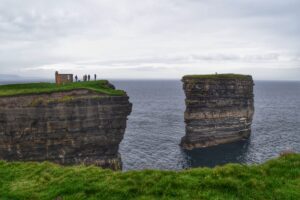Location
Found living on the wildest stretches of coastline along the western freeboard of the Republic of Ireland live a legion of ancient nautical guardians. Over many thousands of our lifetimes, the pounding heart of the Atlantic Ocean has sculptured these guardians. Standing guard at the outer edge of our distant shores these towering rock sentinels mark the boundary between the moving and the static. These sentinels are the last remains of a time and an age long forgotten.
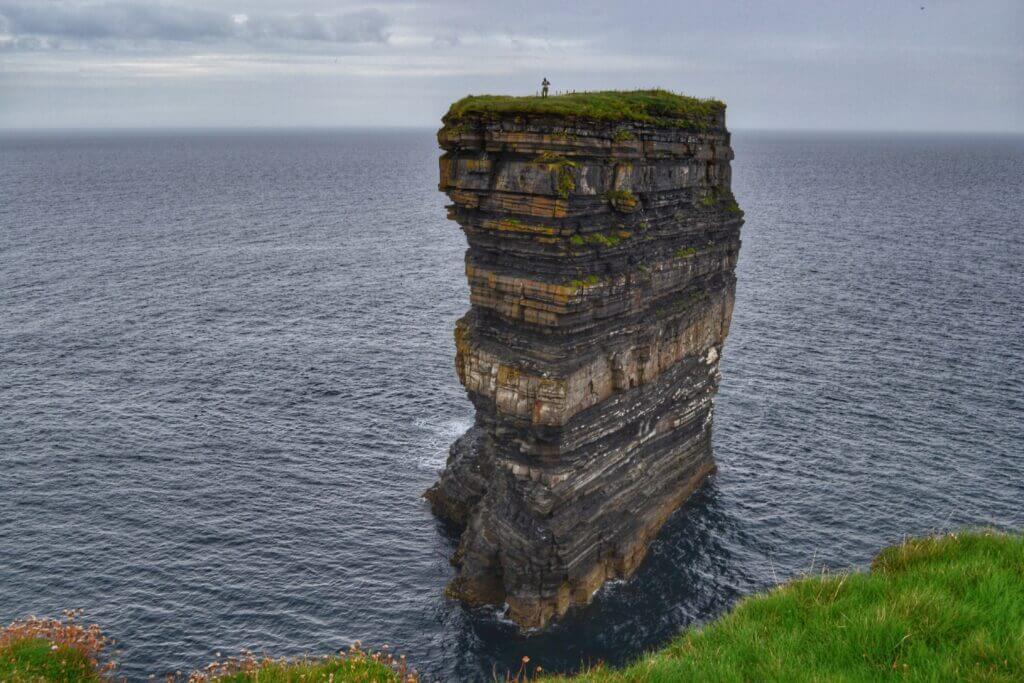
On the north Mayo coast, approximately 80 meters out to sea north from the clifftops at Downpatrick Head resides Dún Bristé. (translates as Broken Fort) This large flat-topped sea stack is one of the most photographed and easily accessible sea stacks on the Irish coast with the clifftops at Downpatrick Head now being one of the Wild Atlantic Way signature points with ample car parking and a wee coffee shop all within a 200-metre easy stroll to the clifftop viewpoint overlooking the stack.
Alas, this is the end of the easy logistics for an ascent of Dún Bristé. As the seas surrounding the base of the stack are a law unto themselves thus making any sane nautical access very difficult to predict.
Dún Bristé History
The stack was detached from the mainland of County Mayo in 1393. Several families stranded on its summit were rescued the following day. In 1980, three scientists landed on the stacks’ summit by helicopter. They had a walkabout and measured the summit and did a bit of an archaeological dig.
The stack had been climbed once before from the sea in 1990 by Mick Fowler, Nikki Duggan and Steve Sustad. Prior to our ascent of the stack, only six people had stood on its summit in the seven hundred years the stack has been in existence. It equates to a summit visit of one person per century.
My Previous Attempts of Dún Bristé
First time
And Sho, the quest to stand on top of Dún Bristé sea stack began with a first visit to Downpatrick Head in June 2015. In attendance for some nautical action were Fionnuala Donnelly, John Mallon and Aidan McGinley. Prior to leaving Donegal, I had made all my usual wind, weather and swell predictions based on local Donegal coastal knowledge and global Synoptics.
Alas upon arrival after a four-hour drive from a flat calm northwest Donegal sea, the mighty Downpatrick Head had a different idea with the north Mayo coast bouncing at 8ft swell from the northwest. This motion was crashing white in the amphitheatre to the south around the base of the stack. All we could do was sit on the clifftops and watch whilst Neptune raged around the base of the stack and battered the coast on either side of us. After a good recce of the area, we headed to Sail Rock and had a wee play on Roaring Forties.
The second visit
The second visit to Downpatrick was in July 2016. This time on for the fray were Denise O’ Doherty and the stalwart clifftop guru Aidan McGinley. Upon arrival, we met local sea kayaker Chris McDaid in the car park and walked to the cliff edge. Alas, this time my nautical predictions were even more incorrect. The sea was bouncing up to 12ft, again from the northwest. We spent the afternoon studying the swell interactions around the base of the stack and the surrounding cliffs with a visit to the cave and channel underneath the head and a paddle around the stack. With these observations, the nautical conundrum of Downpatrick Head had become clear. I now had a very good idea why the amphitheatre around the stack was so prone to Neptune’s wrath.
My third visit to the head was a very brief outing. Having been playing out for a week on Achill Island, I was on my way home when I stopped off for a sunrise visit. On this occasion, I visited the cave under the head again. I sat and watched the movement of the sea around the stack for two hours. I was now ready to climb Dún Briste. All I needed now was a suitably calm sea, good weather, a huge amount of luck, something to calm my growing sense of dread and a climbing partner.
Dún Bristé – the Climb
Getting to the stack
Having spent the month of August with a close eye on the online sea predictions for the north Mayo coast and with great assistance from locals Chris McDaid, David Horkin and Maria Tighe the planets aligned for Saturday 27th and so, we once more set sail for Downpatrick Head.
In the house for a little nautical action on this occasion were Paulina Kaniszewska and of course, Aidan McGinley. After the four-hour drive to County Mayo on a glorious damp and overcast day, we arrived. We raced to the by now familiar clifftops. As a greeting, we had an uber flat calm sea with a subtle hint of distant blue sky on the horizon.
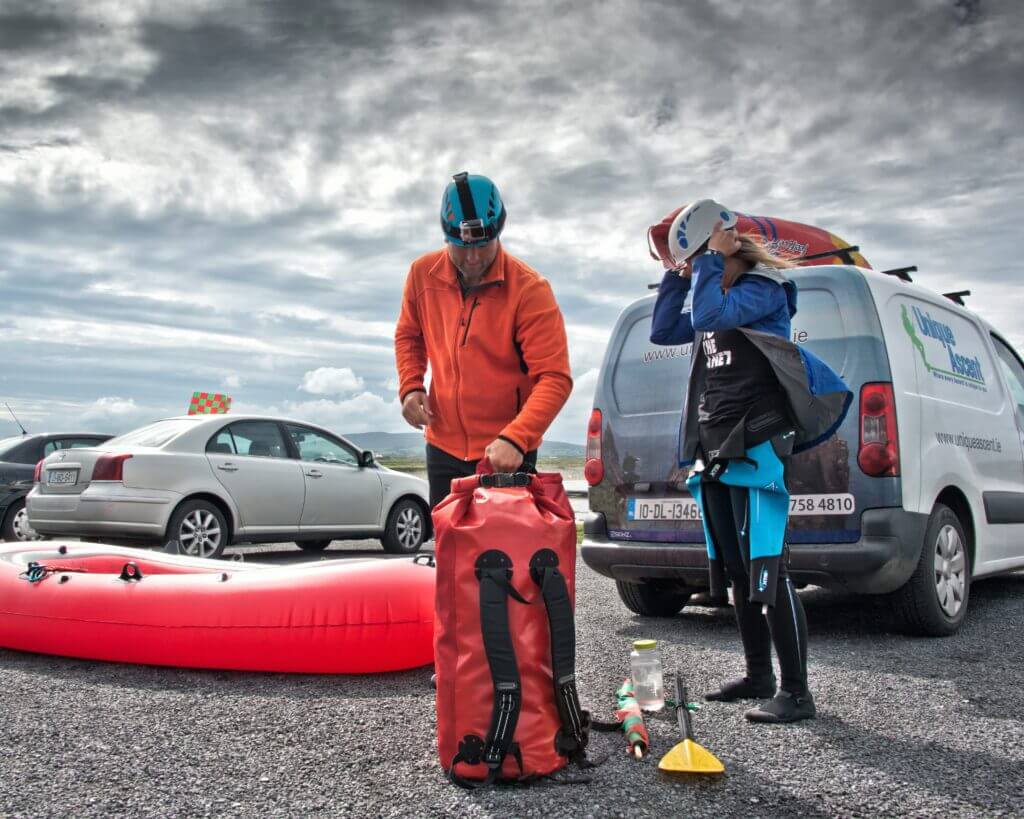
Word of our cunning plan had spread locally and as we inflated the dingy and packed the dry bags in the car park and a steady flow of local people arrived to watch our nautical and vertical antics on the stack. It is quite a surreal and a very unusual position to be in, embarking on a major and mildly concerning climb of this nature in such a public way.
Thankfully our PR guru/clifftop photographer Aidan took his position on the clifftops overlooking the stack and held a live press conference whilst Paulina and I descended to sea level and launched the dingy. From my previous visits finding a good exit point on mainland Mayo and the logistics of the sea crossing held no surprises and very soon we arrived at the huge non-tidal ledges below the west face of the stack, all the time being watched and cheered from the clifftop audience above.
It is only as you are paddling out to the stack in good conditions and knowing you are about to climb it, do you realise just how big the stack is and it is huge, with colossal roofs and Damocles boulders in its upper reaches.
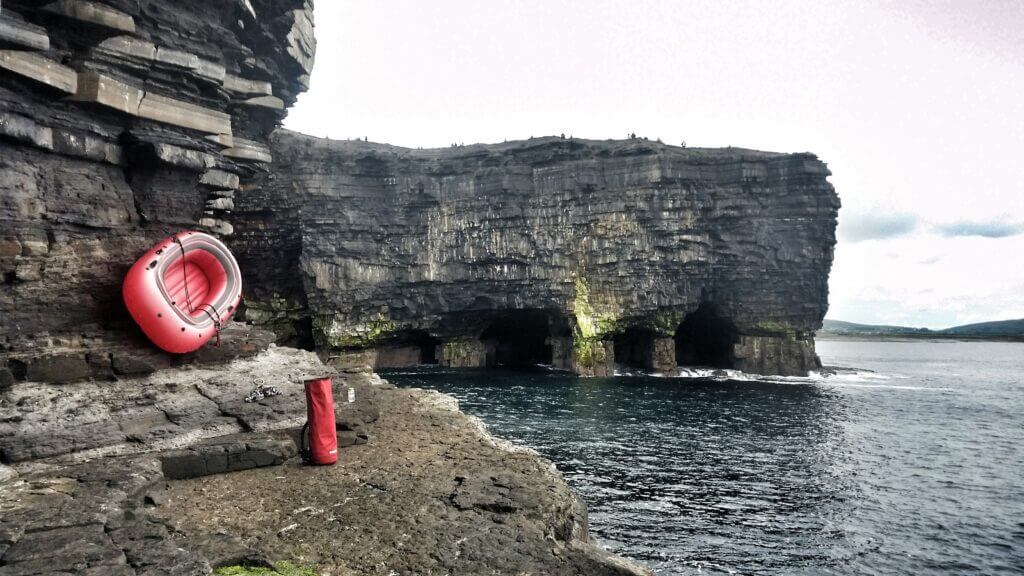
A bad idea?
From our temporary home on the huge ledge system below the west face, we sorted the climbing gear and had a look at our intended route up the seaward face of the stack. Up to this point in time I had intended to follow Mick Fowlers 1990 route up the seaward face. Finding where this climb began was easy enough and leaving Paulina anchored into the ledge system below I made a few moves upwards to Mick’s “interesting overhang” above.
The rock at this point is regularly sea-washed and is of pretty good quality BUT it is north facing and covered in a thin green coating of sandy lichen, the overhang felt hard, greasy, scary, exposed and about another 200 excellent reasons why this was all a very bad idea. I down climbed a move or two and had a look around the corner to find a death drop overlooking the abyss, my heart sank until I saw the juggy handrail spanning across the roof of the abyss.
With a swift thuggy hand traversing over the ocean I reached the salvation of another huge ledge directly below the north face on the stack. From here I followed a series of greasy unprotected ledges to a huge undercut recess/crawl space at the western edge of another huge ledge a shade over a third of the way up the stack, built a good belay in the recess and up came Paulina. We were now 20 or so metres up the stack and above us, it all looked very steep, hard, overhanging and grim.
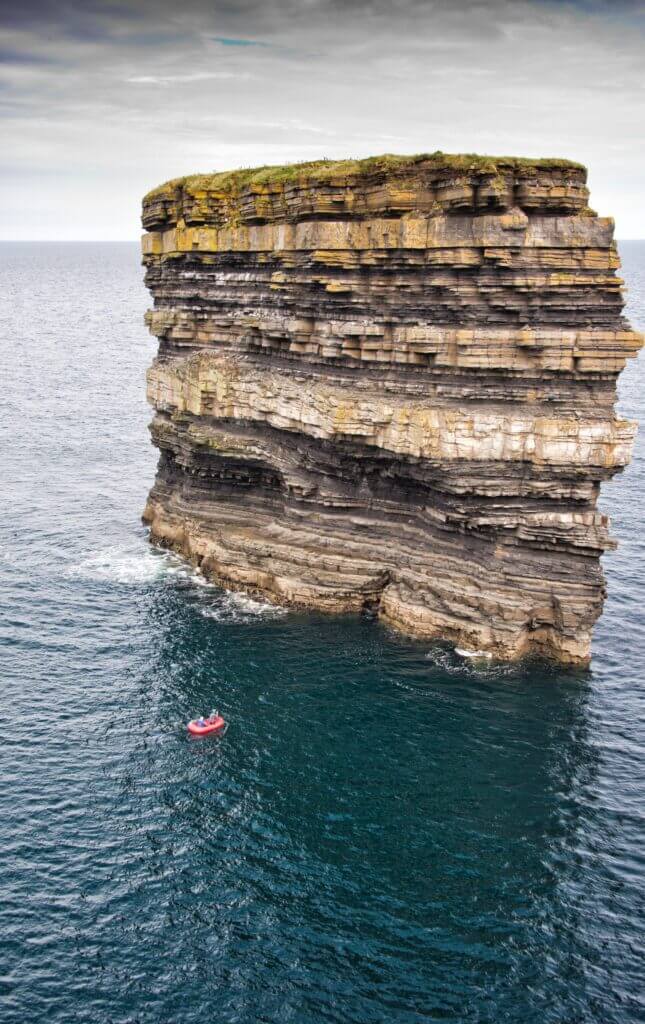
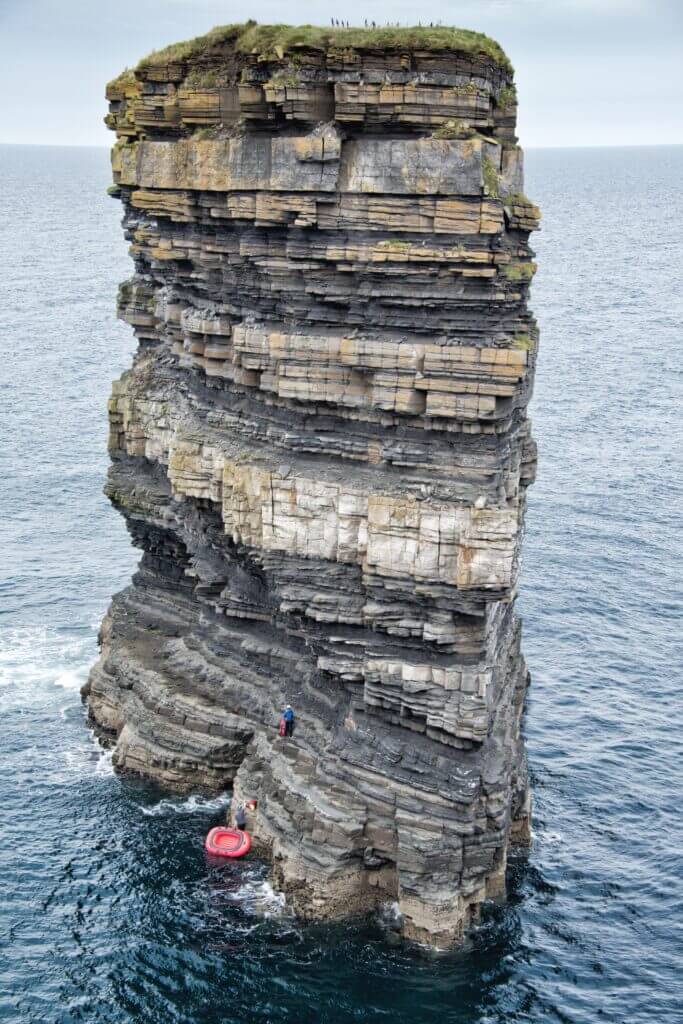
Pitch 2
The crowd
We found Mick Fowlers second pitch above us in the middle of the face and it look very hard, steep and greasy so I started up a thin groove at the far eastern edge of the ledge with a series of 4c/5a moves up to a harder and scary mantle onto a tiny stance. At this point, a few ups and downs were called for and as I was now visible from the clifftops a crowd had begun to gather.
After a moment of calm, a horrendous 5a/5b mantle was made onto the stance above followed by a very runout section of climbing to a larger stance and a thankful mini offset gear placement. The next 15 metres of climbing to the summit were on the underside of terrifying with sparse awful gear between damp greasy bulges of suspect rock to a grovel fest of a chimney and up onto the open expanse of the summit plateau and the rain.
Summiting
I arrived at the summit of the stack to a cheer from the clifftop crowds and the onset of pouring rain. I had a swift lie down on the wet grassy summit tufts to allow my vertically mangled mind to descend from the upper stratosphere to earth again. Once composed I built a grassy tuft belay and Paulina began to climb the, by now soaking wet rock below. Alas, a mini river was seeping down the groove Paulina was trying to climb. After her slipping and sliding about the groove for a while I lowered her back to the top of pitch one and she rebuilt her belay on the ledge below.
On the summit, there are the remains of several houses and livestock enclosures dating from the middle ages. Three unusual finds in the remains were a still functioning Quern Stone, an ancient livestock separation gate which allows sheep to pass from one field to another but restricts cattle from passing through. One says that this Jerusalem Gate dates from biblical times and dozens of golf balls.
Dún Bristé – the Descent
As Paulina was belayed halfway up the seaward face I rigged a grass hummock belay on the summit and began to abseil down the face taking out all the terrible gear placements on the way down. I arrived at Paulina’s stance pretty much both physically and mentally mangled but greatly relieved to be off the abseil.
After a bit of a sit down we began the return to the boat and from here it involved lowering Paulina into the sea for a swim and myself free soloing (unroped climbing) the first pitch in descent. Which took us back to the mighty vessel and the paddle back to the mainland. As the sea was so calm we returned to the mainland through the 500-metre-long sea tunnel underneath Downpatrick Head which involves paddling through the bottom of the blowhole, which is a pretty surreal way to finish an outstanding day out which returned us to the carpark and normality.
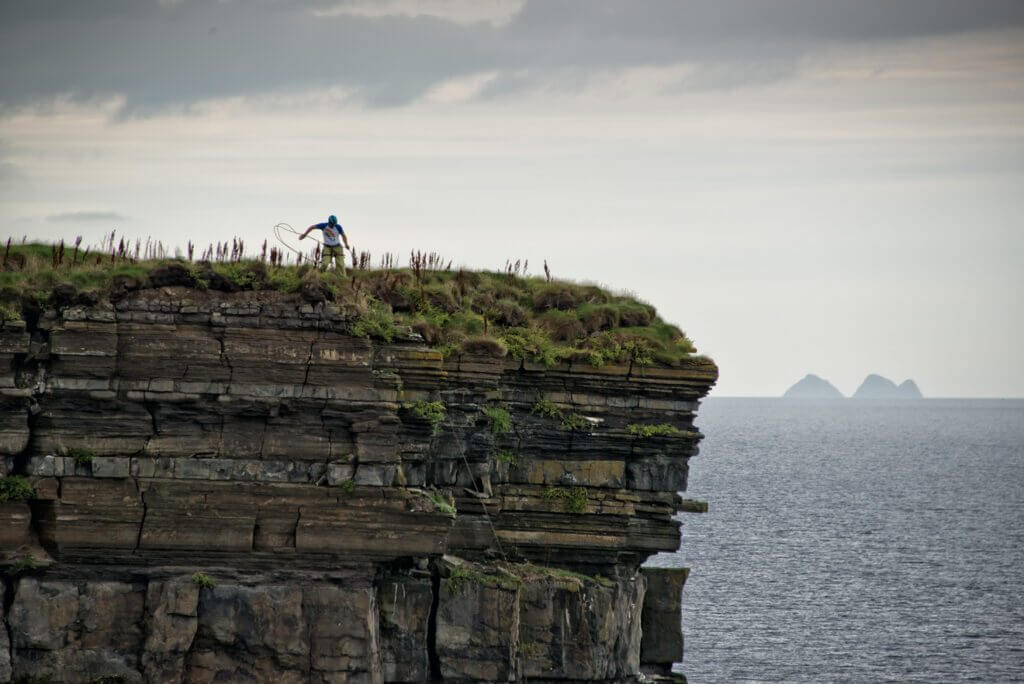
Gear
We used a small inflatable dingy to access and exit the stack sailing from the end of the tidal platforms facing out onto the landward side of the stack and returning through the channel underneath the head to the carpark. We took a standard multi-pitch rack heavy on offset nuts and huge no5 and no6 cams for the wide breaks between bulges. I opted not to take pegs as the first ascent party did not use them on their ascent, alas with hindsight this was not a great decision. We took a 20-metre static and a mailon to rig the abseil with, there are plenty of potential abseil points mid-stack for an exit down the west face.
To access the stack the sea must be peaking at less than 0.5 metre swell from the southwest to west, any north-west to north motion and the game is a bogey. The amphitheatre of cliffs at Downpatrick Head immediately around the stack are vertical to overhanging with huge shallow platforms running into the sea at their bases. The close proximity of these sea cliffs and their platforms at their bases cause a massive amount of white water with north-west to west seas running.
Dún Bristé – Route Descriptions
Doonbristy 42m MXS
Start at the landward side of the ledge system at 15m on the west face. The route follows the seaward arete of the stack, mainly on the left-hand side. The stack became disconnected from the headland in 1393 and the fort on top has been isolated since then.
Pitch 1. 18m 5a/b Climb up right-wards over an interesting overhang (on good holds) to gain a shallow groove in a band of lighter-coloured rock. Climb this to an excellent ledge on the arete.
Pitch 2. 24m 5a/b Climb onto a projecting ledge above the stance and gain a much smaller projecting ledge above. A short wall leads to a good ledge and easier (but loose) ground leading to the top.
M. Fowler, N. Duggan, S. Sustad May 1990
Chaos Theory 42m XS
There is a huge non-tidal ledge system at the base (approx 10m above the sea) of the west face.
Pitch 1: 18m 4b From the seaward end of the walkable ledge make a couple of moves up to the grim-looking overhang. After a couple of ups and downs, the hand traverse left above the void to the sanctuary of a large non-tidal ledge. Climb up and over the steps above and crawl through the birded gap above.
Pitch 2. 24m 5a/b At the far left of the huge ledge climb the well-protected groove with a hard move onto the ledge system above. Run it out forever (8mish) to a small crack in the suspect rock above. Climb grooves and ledge systems above to finish up a superb layback corner and awful chimney above.

